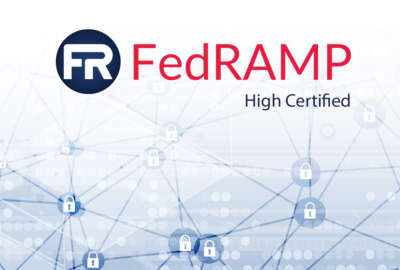Hubbard Radio Washington DC, LLC. All rights reserved. This website is not intended for users located within the European Economic Area.
DoD Cloud Exchange 2024: DISA’s Korie Seville on crafting cloud products that easily adapt to user need
The Hosting and Compute Center at DISA creates new services to lower the barrier to quick cloud adoption and scalability.
Rank Korie Seville among the Defense Department’s go-to guys for cloud computing smarts.
Seville’s title at the Defense Information Systems Agency might sound a bit cryptic: deputy chief technology officer for compute and senior technical adviser for J9 hosting and compute. But he’s clear about his two-hatted role helping Defense Department agencies succeed in their cloud deployments.
At the J9 — Joint Operations and Plans Directorate — level, “I basically act as an integration point between DISA’s hosting and compute directorate and the rest of the agency from a cloud computing perspective,” Seville said during Federal News Network’s DoD Cloud Exchange 2024. “At the external level, I basically work with other agencies’ CTO- level engineers and leaders within different agencies to advise them on their cloud portfolios, their migration strategies and their overall hosting and compute strategies.”
Seville said that cloud computing, as agencies move from simply hosting applications to reworking them into microservices, has enhanced DoD’s capability to distribute workloads and create greater resiliency. The evolution also improves computing outside the continental United States (OCONUS), a critical DISA and DoD challenge generally.
Defense users gain “the capability to expand and get better services, no matter where they are across the world,” he said.
Tapping cloud effectively OCONUS
Asked about DISA’s signature cloud computing contracts, known collectively as the Joint Warfighting Cloud Capability, Seville said the program supports OCONUS needs by easing the buying process for cloud. JWCC “is just an acquisition vehicle,” he said. “It’s a way to purchase cloud, but it doesn’t necessarily by itself solve the OCONUS problem.”
Contractors on JWCC, though, do provide a variety of tactical edge platforms, ranging from modular data centers to backpack-sized computing units.
It’s in how teams want to use the cloud and transform how they deliver the mission that’s an intense focus for DISA and Seville. For instance, what if say two deployed teams focused on the same area of responsibility want to be able to collaborate, he said. How would that happen? How could it be done as an operational expense “instead of having to put a large capital investment in to utilize these cloud capabilities?” Seville said
One answer is Stratus, a government-owned cloud product DISA has deployed in Hawaii, he said. A second option is DISA’s joint operational edge product that uses public clouds. Seville said DISA partners with the DoD chief information officer “to push public cloud capabilities to the OCONUS user community.” A new instance of that capability is under development for Japan and a couple of other locations.
Basically, it consists of one of the commercial cloud services providers, in this case Amazon, providing its hardware housed in DISA secure facilities and operated by government employees. Seville said DISA plans to add the other JWCC suppliers “to be able to get their enterprise-grade deployable solutions, put them in our facilities and have them there for consumption.”
Seville said his group partners closely with DISA’s program executive office for transport, which manages the network connections needed for computing nodes to communicate with one another.
“Their technical director and myself stay very connected. We basically sit together and share roadmaps,” he said, adding that sometimes “my roadmap is going this way, your roadmap is going that way.”
When that happens, the two offices work out “where can we meet and take advantage of some of the resiliency that each of us is building in to make our products operate better together,” Seville said. But they leave the choice of specific transport options to the users, he said.
Providing new DISA common services for the cloud
Another DISA cloud project now under development, and dubbed Olympus, focuses on common services that surround cloud workloads.
“These are things like name resolution, Domain Name System capabilities, certificates, network time — all of these things that are often overlooked in application deployment,” Seville said. “but they’re crucial to getting an application off the ground.”
Olympus will provide these services as needed. Two minimally viable products created so far for Olympus focus on core competencies:
- Network connectivity and boundary protection
- A basic suite of common services
The addition of common services elements will result in what Seville called a managed platform, “where the customers can just come in and drop their apps, and we remove the burden, or share the burden, of bringing all of those common services up and operational.”
The basic goal is to help DISA’s customers access meet cloud needs quickly by “really lowering the barrier for entry for getting started in cloud.” He pointed out that the Air Force’s Cloud One and the Navy’s Flank Speed programs provide similar services. But because those service-driven projects are focused on their respective organizations, “we designed Olympus to catch the customers that may have fallen through the cracks,” Seville said.
DISA hosts the pilot version of Olympus in the Microsoft Azure cloud. Seville stressed that the Hosting and Compute Center (HAC) takes an iterative approach informed by customer feedback when crafting products, Olympus included.
“When we develop any of our capabilities, we really try to get away from that five-year plan, 10-year plan, where we know exactly where we’re going to go and nothing can force us to deviate,” he said, and added, “The most important thing to us is our customers, the warfighters. They know their missions better than we do. For us to prescribe where we’re going to go doesn’t make sense if our goal is to support the warfighter.”
Ensuring ‘optionality’ in all DISA cloud offerings
HAC views providing choice as a foundational factor in helping DoD users implement the cloud capabilities they need to meet their specific situations and missions.
“One of the design tenets, and one of the tenets of our entire organization, has been optionality,” Seville said. “And so when I have an OCONUS user who’s trying to build out a capability, we’re going to provide them with a menu of options.”
He used the analogy of a pizza parlor menu, where a customer can choose from a variety of toppings for their pie: “Do they want a combination of tactical edge, operational edge and maybe some data center as a service to give them the ultimate level of resilience? Or do they want to go strictly tactical edge and just maintain local ownership of that computing capability?”
As cloud hosting has taken hold in DoD, Seville said he’s now seeing increased use of the elasticity and flexibility cloud computing offers. An important reason is that early estimates of cost savings from simply shifting workloads failed to pan out.
“People are starting to realize that taking advantage of elastic scale, taking advantage of serverless capabilities, that’s how you’re going to save that money,” he said. To get there, though, application owners will have to go the refactoring or redeveloping route. And he said users will also have to keep rationalizing their application sets, retiring those that won’t work in the cloud.
“There is an app refactor model that has to take place in order for you to effectively take advantage of elastic scale,” Seville said. DISA can partner with users redoing applications to help them fully realize cloud benefits.
By going to containerization and microservices for applications, Seville said, users will get closer to cloud interoperability and easily moving workloads among competing cloud providers. That vision of a “cloud-agnostic, multicloud, hybrid cloud, pick-up-an-app-and-move-it-wherever-I-want model really relies on that app rationalization, that app modernization framework.”
Discover more articles and videos now on Federal News Network’s DoD Cloud Exchange event page.
Copyright © 2024 Federal News Network. All rights reserved. This website is not intended for users located within the European Economic Area.
Tom Temin
Tom Temin is host of the Federal Drive and has been providing insight on federal technology and management issues for more than 30 years.
Follow @tteminWFED
Related Stories
Protected: Cloud, AI and software-as-a-service form path to modernized HR
Related Stories
-
OMB’s new FedRAMP policy takes aim at the pain points Cloud Computing
-
Ready, set, run: Meeting users’ tech expectations and needs now Cloud Computing





